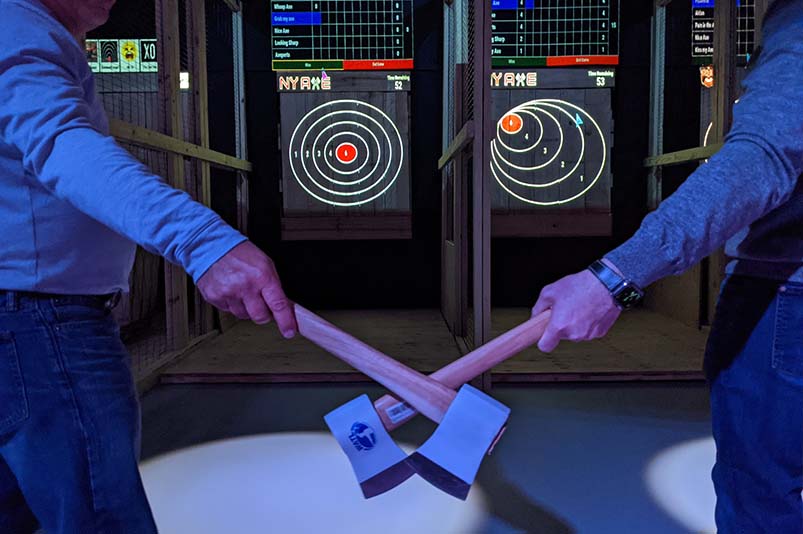Axe Throwing Denver CO: Fun for Everyone, from Friends to Households
Axe Throwing Denver CO: Fun for Everyone, from Friends to Households
Blog Article
The Fun of Axe Throwing: Just How This Sporting Activity Combines Ability and Adrenaline for a Fun Time
Axe throwing has emerged as a captivating sport that masterfully intertwines the demand for accurate skill with the thrill of adrenaline, offering individuals a interesting and unique experience. The act of hurling an axe in the direction of a target requires focus and technique, all at once cultivating an environment of camaraderie and pleasant rivalry.
The Beginnings of Axe Throwing
Axe tossing, a recreational task that has obtained considerable appeal over the last few years, traces its origins back to ancient times. This primal sporting activity dates back to early human history, when axes were mostly used as tools and weapons. The earliest records of axe usage in competitive contexts are located amongst the Celts and Vikings, that threw axes for sporting activity in addition to in battle training. The practice was not just a pastime yet an important skill for survival and warfare.
Medieval European warriors, specifically during the Center Ages, practiced axe tossing as component of their martial training. The Francisca, a kind of tossing axe made use of by the Franks, became legendary for its fatal precision. This typical weapon was designed to be tossed at enemy guards and armor, showcasing its twin utility in both sporting activity and fight.
In even more current history, axe tossing saw a resurgence in the logging camps of The United States and copyright in the 19th and 20th centuries. Lumberjacks would certainly participate in friendly competition, testing their precision and toughness by focusing on wood targets. This advancement from a survival ability to an entertainment activity has actually led the way for its modern-day rebirth, with devoted locations and leagues currently commemorating the sport worldwide.
Tools You Required
Comprehending the rich history of axe tossing enhances the appreciation of the sporting activity's modern iteration. Central to this thrilling activity is the tools, which is important for both security and performance. The primary tool is, of training course, the axe. For recreational and competitive axe throwing, one of the most typically utilized kind is the hatchet, commonly considering between 1.25 to 2 pounds with a handle length of around 16 inches. The axe ought to have a sharp, well-maintained blade and a handle made from long lasting wood or composite material, guaranteeing a great hold and equilibrium.
Just as essential is the target. Regulation targets are built from wood, with softwood varieties like ache or cottonwood being liked for their ability to absorb and hold the axe. The target is typically separated into 5 concentric circles, each with a certain point worth, to assist in scoring.
Safety and security gear, however typically overlooked, is vital. Protective handwear covers can enhance grasp and avoid sores, while closed-toed shoes are a should to safeguard feet from gone down axes (axe throwing denver colorado). A well-lit, spacious tossing area, full with safety obstacles, ensures a regulated environment where individuals can concentrate on sharpening their abilities.
Standard Techniques Explained
Grasping the fundamental methods of axe throwing is crucial for both security and proficiency. The dominant hand ought to be placed straight listed below the axe head, while the non-dominant hand sustains the end of the handle.
Your leading foot needs to be somewhat forward, aligning with your target. This positioning aids in preserving stability and routing power properly in the direction of the target.

Safety And Security First
Making certain security in axe throwing is paramount to creating an injury-free and enjoyable experience. Security measures begin with the location design. A well-designed axe tossing facility functions clear demarcations in between tossing lanes, tough backgrounds to catch roaming axes, and non-slip floor covering to stop crashes. Additionally, adequate lighting is critical to assist participants preserve visual precision and spatial understanding.
Benefits of Axe Throwing
Axe tossing deals a myriad of benefits that extend beyond basic entertainment. The repeated motion of throwing the axe also enhances hand-eye coordination and fine motor abilities.
Emotionally, axe throwing needs technique, focus, and accuracy, making it an outstanding way to sharpen cognitive skills. The focus needed to strike the target can act as a type of mindfulness, permitting participants to remove their minds and decrease anxiety. This psychological involvement can be especially valuable in aiding individuals create far better analytic skills and psychological strength.
Socially, axe throwing is usually appreciated in group settings, fostering team-building and sociability. Whether as part of a company occasion or an informal outing with close friends, the sporting activity urges communication and cooperation. Additionally, the public experience of learning and enhancing with each other can reinforce partnerships and create enduring memories.
Conclusion

The earliest documents of axe usage in competitive contexts are discovered among the Celts and Vikings, who tossed axes for sporting activity as well as in fight training. Release the axe when your hands are around at eye degree, allowing the axe's all-natural rotation to assist it in the direction of the target.
A properly designed axe tossing facility features clear demarcations in between throwing lanes, durable backgrounds to capture roaming axes, and non-slip flooring to avoid accidents. Participants need to be advised on the correct way to deal with and throw the Discover More axe, stressing managed, calculated movements find more information over forceful throws.
In summary, axe tossing stands out as a sporting activity that masterfully integrates adrenaline, accuracy, and ability.
Report this page